从句归纳 区分定语从句、宾语从句、同位语从句之欧阳家百创编
- 格式:doc
- 大小:36.01 KB
- 文档页数:16
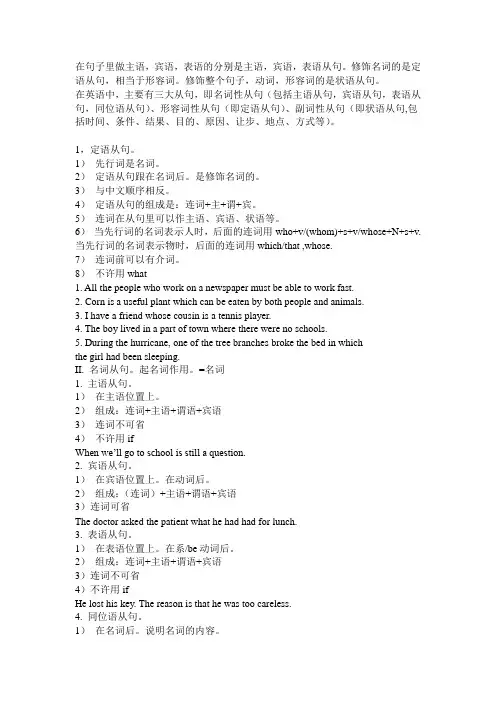
在句子里做主语,宾语,表语的分别是主语,宾语,表语从句。
修饰名词的是定语从句,相当于形容词。
修饰整个句子,动词,形容词的是状语从句。
在英语中,主要有三大从句,即名词性从句(包括主语从句,宾语从句,表语从句,同位语从句)、形容词性从句(即定语从句)、副词性从句(即状语从句,包括时间、条件、结果、目的、原因、让步、地点、方式等)。
1,定语从句。
1)先行词是名词。
2)定语从句跟在名词后。
是修饰名词的。
3)与中文顺序相反。
4)定语从句的组成是:连词+主+谓+宾。
5)连词在从句里可以作主语、宾语、状语等。
6)当先行词的名词表示人时,后面的连词用who+v/(whom)+s+v/whose+N+s+v. 当先行词的名词表示物时,后面的连词用which/that ,whose.7)连词前可以有介词。
8)不许用what1. All the people who work on a newspaper must be able to work fast.2. Corn is a useful plant which can be eaten by both people and animals.3. I have a friend whose cousin is a tennis player.4. The boy lived in a part of town where there were no schools.5. During the hurricane, one of the tree branches broke the bed in whichthe girl had been sleeping.II. 名词从句。
起名词作用。
=名词1. 主语从句。
1)在主语位置上。
2)组成:连词+主语+谓语+宾语3)连词不可省4)不许用ifWhen we’ll go to school is still a question.2. 宾语从句。
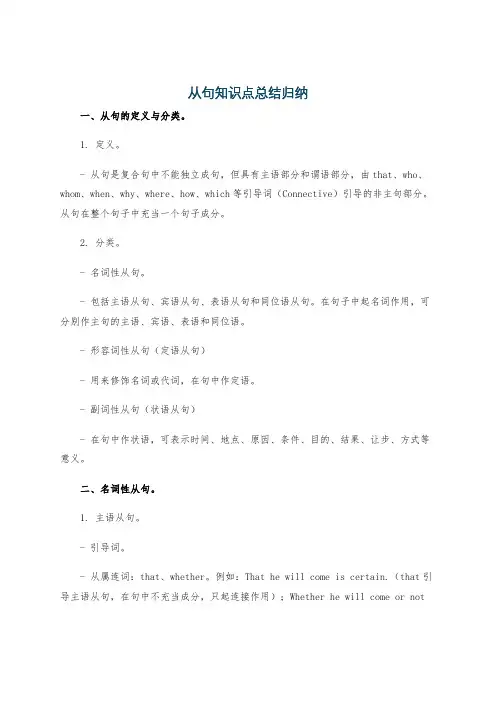
从句知识点总结归纳一、从句的定义与分类。
1. 定义。
- 从句是复合句中不能独立成句,但具有主语部分和谓语部分,由that、who、whom、when、why、where、how、which等引导词(Connective)引导的非主句部分。
从句在整个句子中充当一个句子成分。
2. 分类。
- 名词性从句。
- 包括主语从句、宾语从句、表语从句和同位语从句。
在句子中起名词作用,可分别作主句的主语、宾语、表语和同位语。
- 形容词性从句(定语从句)- 用来修饰名词或代词,在句中作定语。
- 副词性从句(状语从句)- 在句中作状语,可表示时间、地点、原因、条件、目的、结果、让步、方式等意义。
二、名词性从句。
1. 主语从句。
- 引导词。
- 从属连词:that、whether。
例如:That he will come is certain.(that引导主语从句,在句中不充当成分,只起连接作用);Whether he will come or notis still a question.(whether表示“是否”,引导主语从句,在句中不充当成分)。
- 连接代词:who、what、which、whom、whose等。
例如:Who will be our monitor hasn't been decided yet.(who在主语从句中作主语)。
- 连接副词:when、where、why、how等。
例如:How we can solve this problem is very important.(how在主语从句中作方式状语)。
- 注意事项。
- 为避免头重脚轻,常用it作形式主语,而将真正的主语从句后置。
例如:It is known to all that the earth goes around the sun.2. 宾语从句。
- 引导词。
- 与主语从句基本相同,从属连词that(可省略)、whether/if;连接代词和连接副词。
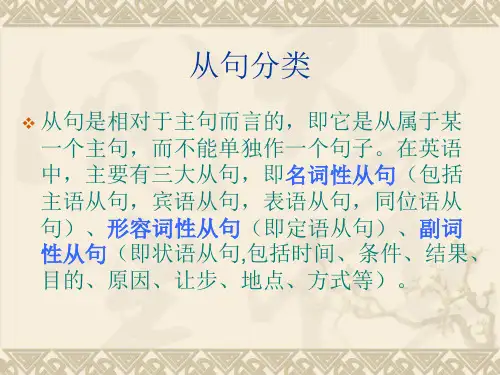
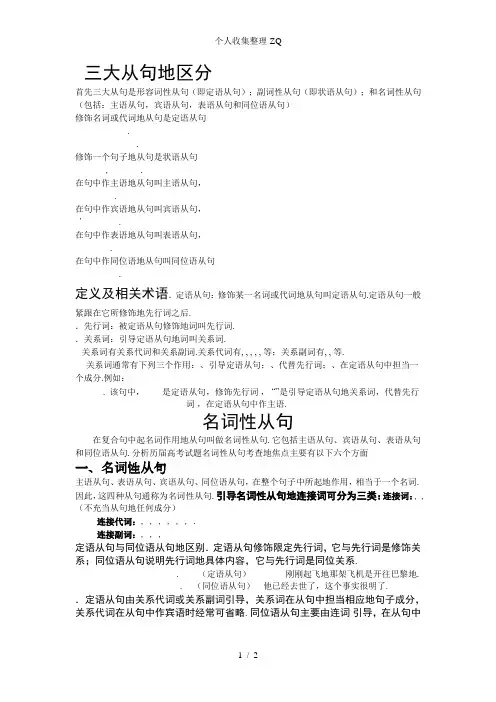
三大从句地区分首先三大从句是形容词性从句(即定语从句);副词性从句(即状语从句);和名词性从句(包括:主语从句,宾语从句,表语从句和同位语从句)修饰名词或代词地从句是定语从句..修饰一个句子地从句是状语从句, .在句中作主语地从句叫主语从句,.在句中作宾语地从句叫宾语从句,' .在句中作表语地从句叫表语从句,.在句中作同位语地从句叫同位语从句.定义及相关术语.定语从句:修饰某一名词或代词地从句叫定语从句.定语从句一般紧跟在它所修饰地先行词之后..先行词:被定语从句修饰地词叫先行词..关系词:引导定语从句地词叫关系词.关系词有关系代词和关系副词.关系代词有, , , , , 等;关系副词有, , 等.关系词通常有下列三个作用:、引导定语从句;、代替先行词;、在定语从句中担当一个成分.例如:b5E2R。
. 该句中,是定语从句,修饰先行词,“”是引导定语从句地关系词,代替先行词,在定语从句中作主语.p1Ean。
名词性从句在复合句中起名词作用地从句叫做名词性从句.它包括主语从句、宾语从句、表语从句和同位语从句.分析历届高考试题名词性从句考查地焦点主要有以下六个方面一、名词性从句DXDiT。
主语从句、表语从句、宾语从句、同位语从句,在整个句子中所起地作用,相当于一个名词.因此,这四种从句通称为名词性从句.引导名词性从句地连接词可分为三类:连接词:, , (不充当从句地任何成分)连接代词:, , , , , , .连接副词:, , , RTCrp。
定语从句与同位语从句地区别.定语从句修饰限定先行词,它与先行词是修饰关系;同位语从句说明先行词地具体内容,它与先行词是同位关系.. (定语从句)刚刚起飞地那架飞机是开往巴黎地.. (同位语从句)他已经去世了,这个事实很明了..定语从句由关系代词或关系副词引导,关系词在从句中担当相应地句子成分,关系代词在从句中作宾语时经常可省略.同位语从句主要由连词引导,在从句中一般不担当成分;有时也由,,,,,等连词引导,这些连词则在从句中担当成分.5PCzV。
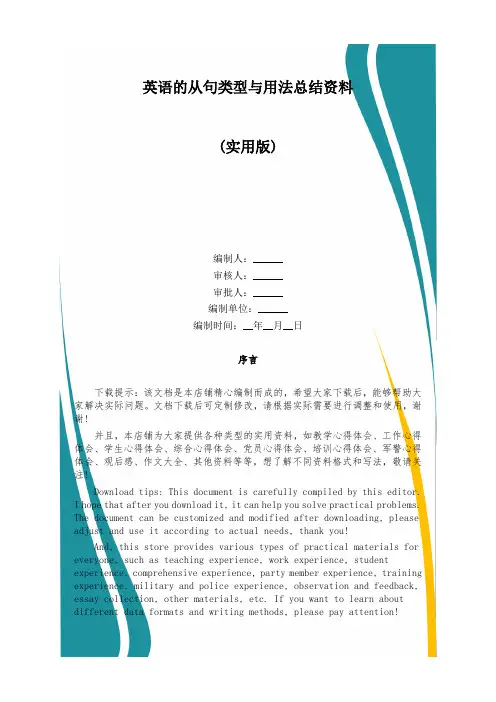
英语的从句类型与用法总结资料(实用版)编制人:______审核人:______审批人:______编制单位:______编制时间:__年__月__日序言下载提示:该文档是本店铺精心编制而成的,希望大家下载后,能够帮助大家解决实际问题。
文档下载后可定制修改,请根据实际需要进行调整和使用,谢谢!并且,本店铺为大家提供各种类型的实用资料,如教学心得体会、工作心得体会、学生心得体会、综合心得体会、党员心得体会、培训心得体会、军警心得体会、观后感、作文大全、其他资料等等,想了解不同资料格式和写法,敬请关注!Download tips: This document is carefully compiled by this editor.I hope that after you download it, it can help you solve practical problems. The document can be customized and modified after downloading, please adjust and use it according to actual needs, thank you!And, this store provides various types of practical materials for everyone, such as teaching experience, work experience, student experience, comprehensive experience, party member experience, training experience, military and police experience, observation and feedback, essay collection, other materials, etc. If you want to learn about different data formats and writing methods, please pay attention!英语的从句类型与用法总结资料英语语法不多,但是高中语法对大家来说稍有难度,所以还应以理解为主,易混淆的语法要放在一起进行对比记忆。

英语八大从句类型与用法总结有哪些从句英语有六种从句类型,分别是主语从句、表语从句、宾语从句、同位语从句、定语从句、状语从句。
英语从句类型主语从句用作主语的从句叫主语从句。
引导主语从句的关联词有从属连词、疑问代词、疑问副词、缩合连接代词、缩合连接副词等。
表语从句用作表语的从句叫做表语从句。
引导表语从句的关联词与引导主语从句的关联词许多都一样。
宾语从句在句子中起宾语作用的从句叫做宾语从句.宾语从句分为三类:动词的宾语从句、介词的宾语从句和形容词的宾语从句。
同位语从句是名词性从句(主语从句、表语从句、宾语从句、同位语从句)中的主要从句之一,从句作同位语表示与之同位的名词(短语)的实际内容,它的作用相当于名词,对前面的名词(短语)加以补充说明或进一步解释,相当于一个表语从句,它们之间的关系就是同位关系,即主表关系。
定语从句是由关系代词或关系副词引导的从句,其作用是作定语修饰主句的某个名词性成分,相当于形容词,所以又称为形容词性从句,一般紧跟在它所修饰的先行词后面。
状语从句可分为:时间状语从句、地点状语从句、缘由状语从句、条件状语从句、目的状语从句、让步状语从句、比较状语从句、方式状语从句、结果状语从句。
英语从句用法1.主语从句1)主语从句可直接位于主语的位置,假如从句较长,谓语又较短,可用it作形式主语,而将从句放在句末。
常见的句型有:2)what引导的主语从句表示“...的东西时”,一般不用it作形式主语。
3)what,who,when,why,whether等词含有各自的疑问意义,但它们引导的主语从句,都用陈述语序。
2.宾语从句1)宾语从句可位于及物动词、介词和某些形容词后。
连词that 常可省略。
介词后一般接疑问词引导的宾语从句。
in that(由于),except that(除了),but that(只是)已构成固定搭配,其他介词后一般不接that引导的宾语从句。
2)宾语从句后如有宾补,要用形式宾语it来代替,而把宾语从句移至宾补之后。

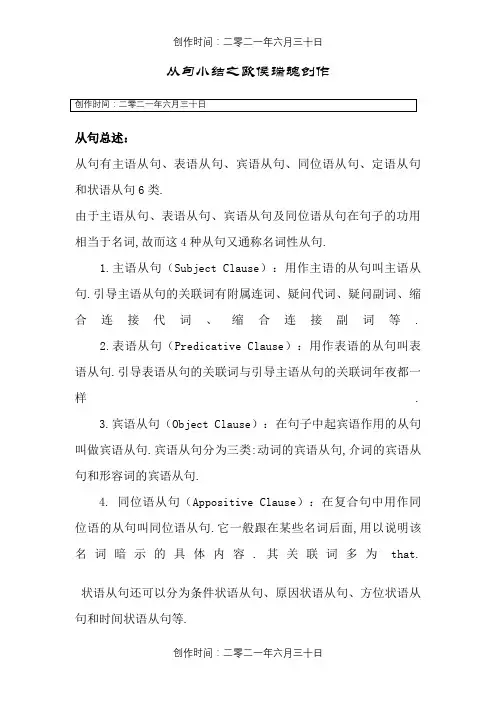
从句小结之欧侯瑞魂创作从句总述:从句有主语从句、表语从句、宾语从句、同位语从句、定语从句和状语从句6类.由于主语从句、表语从句、宾语从句及同位语从句在句子的功用相当于名词,故而这4种从句又通称名词性从句.1.主语从句(Subject Clause):用作主语的从句叫主语从句.引导主语从句的关联词有附属连词、疑问代词、疑问副词、缩合连接代词、缩合连接副词等.2.表语从句(Predicative Clause):用作表语的从句叫表语从句.引导表语从句的关联词与引导主语从句的关联词年夜都一样.3.宾语从句(Object Clause):在句子中起宾语作用的从句叫做宾语从句.宾语从句分为三类:动词的宾语从句,介词的宾语从句和形容词的宾语从句.4. 同位语从句(Appositive Clause):在复合句中用作同位语的从句叫同位语从句.它一般跟在某些名词后面,用以说明该名词暗示的具体内容.其关联词多为that. 状语从句还可以分为条件状语从句、原因状语从句、方位状语从句和时间状语从句等.宾语从句学习宾语从句要抓住三要素:时态、语序、连接词.一:时态和语序1·主句用一般现在时,从句可用任意时态.2·主句用过去时,从句用过去某个时态.3·主句用过去时,从句是真理时,只用一般现在时.语序:宾语从句只能用陈说句语序,坚决不能用疑问句语序.二:连接词①附属连词连接宾语从句的附属连词主要有that,if,whether. that引导暗示陈说句的宾语从句,而if和whether引导暗示“是否”的宾语从句.例句:He told that he would go to the college the next year 他告诉我他下一年上年夜学.I don’t know if there will be a bus any more.我不知道是否还会有公交车.②连接代词连接代词主要有who, whom ,whose ,what ,whoever ,whomever ,whosever, whatever, whichever等.连接代词一般指疑问,但what, whatever除指疑问外,也可以指陈说.例句:Do you know who has won Red Alert game?你知道谁赢了这一局红警游戏吗?③连接副词连接副词主要有when,where,why,how,whenever,wherever,however等.例句:He didn’t tell me when we should meet again.他没有告诉我什么时候我们能再见面.三:动词的宾语从句We all expect that they will win , for members of their team are stronger.我们都预料他们会赢,因为他们的队员更强壮.I have found out that all the tickets for the concert have been sold out.我发现这场音乐会的所有票都卖光了.make sure确保make up one’s mind下决心 keep in mind 牢记例句:Make sure that there are no mistakes in your papers before you turn them in.在上交试卷前确保没有任何毛病.四:可运用形式宾语it取代的宾语从句①动词find,feel,consider,make,believe等后面有宾语补足语的时候,则需要用it做形式宾语而将that宾语从句后置.例句:I think it necessary that we take plenty of hot water every day .我认为每天多喝开水是有需要的.I feel it a pity that I haven’t been to the get-together.我没去聚会,感觉非常遗憾.②有些动词带宾语从句时寻要在宾语与从句前加it这类动词主要有:hate, take , owe, have, see to.例句:I hate it when they with their mouths full of food.我讨厌他们满嘴食物时说话.五:介词的宾语从句用wh-类的介词宾语从句例句:We are talking about whether we admit students intoour club.我们正在讨论是否让学生加入我们的俱乐部.I know nothing about my new neighbor except that he used to work with a company.对我的新邻居我只知道他曾在一家公司上班,其他一无所知.六:形容词的宾语从句一般来说形容词不能带宾语,更不能带宾语从句.但以下形容词除外:sure,certain,glad,please,happy,sorry,afraid,satisfied,sur prised例句:I am sure I will pass the exam.我确信我会通过考试.I am sorry that I have troubled you so long.很抱愧我这么长时间在打搅你.七:if,whether在宾语从句中的区别①if和whether在作“是否”解时,引导宾语从句常放在动词know,ask,care,wonder,find out等之后,介词后一般不用if②少数动词,如:leave,put,discuss,doubt后的宾语从句经常使用whether.③whether后可以加or not,可是if不成以.④在不定式前只能用whether.如:I can’t decide whether to stay. 我不能决定是否留下.⑤防止歧异时,我们经常使用whether而不用if.八:哪些宾语从句不成以省略引导词that①当一个动词带有两个或两个以上宾语从句时,此时第一个that可以省略,第二个that不成以省略;②当宾语从句有it做其先行词时;九:宾语从句的否定转移主句的谓语动词是think,believe,imagine,suppose,consider,espect,fancy,guess 等,而且主句的主语是第一人称而且为一般现在时,从句的否定词一般要转移到主句上来,其反义疑问句一般与宾语从句一致.例句:I don’t think he will come to my party.而不能说成I t hink he won’t come to my party.我认为他不会来我的舞会.I don’t believe that man is killed by Jim,is he?我认为那个人不是Jim所杀的,是不是?★如果宾语从句中有某个含有否定意义的形容词或副词,其反义疑问句要用肯定形式.例句:We find that he never listens to the teachercarefully,does he?我们发现他历来不仔细听老师讲课,是不是?十:宾语从句的时态和语序当主句为现在时或将来时的时候,宾语从句的时态一般不受主句的时态所影响.当主句为过去时的时候,从句只能用和过去相关的时态.例句:The reporter asked if the government would take necessary measures to put down the to-do.记者问政府是否会采用需要的办法镇压骚乱.★如果从句是一个客观真理,那么从句的时候不根据主句的时态而变动例句:The teacher said that the moon goes around the earth yesterday.老师昨天说月亮绕着地球转.★宾语从句的拔出语形式例句:Who do you think the public might choose as their favorite singer this year?你认为今年公众会选谁为他们最喜欢的歌手.同位语从句(Appositive Clause):在复合句中用作同位语的从句叫同位语从句.它一般跟在某些名词后面,用以说明该名词暗示的具体内容.其关联词多为that.一、如:I heard the news that our team had won.我听到了我们队获胜的消息.I had no idea that you were here.我不知道你在这里.二、可以跟同位语从句的名词通常有news,idea,fact,promise,question,doubt,thought,hope,messag e,suggestion,words(消息),possibility等,可展开来的笼统名词.如:I’ve come from Mr wang with a message that he won’t be able to see you this afternoon.我从王先生那里来,他让我告诉你他今天下午不能来看你了.三、英语中引导同位语从句的词通有连词 that,whether,连接副词 how,when,where等.根据句意决定该用哪一个.l have no idea When he will be back.我不知道他什么时候回来.定语从句(Attributive Clause):用作定语的从句叫定语从句.定语从句一般皆放在被它所修饰的名(代)词之后,这种名(代)词就叫作先行词(Antecedent).引导定语从句的关联词为关系代词和关系副词.关系代词在定语从句中可用作主语、宾语、定语等;关系副词在定语从句中用作状语.①引导定语从句的关联词有who, whom, whose, that, when, where, why 和 which. 在非限制定语从句中, 只可用which, who, whose, where , when., 如果指代前面整个句子, 多用which.例句:The dog that/which was lost has been found. (失踪的狗已经找到了.)Those who are in favor of the proposal are expected to discuss it in detail after the meeting. (有人认为那些对这个提案有兴趣的人最好是在会后再具体讨论它.)There are many organizations whose purpose is to help the homeless. (存在着许多旨在帮手无家可归者的组织.)②当引导定语从句的先行词前有all, any, no, little, much, very first 等词, 或先行词前为形容词最高级所修饰时,或先行词为all, anything, nothing, something, everything 时,从句的引导词只能用that.The only thing that matters to the children is how soon they can have their holiday. (孩子们唯一关心的是他们什么时候放假.)These are the very points that puzzle me. (真正困扰我的是这些观点.)Is there anything that bothers you? (有什么事烦着你吗?)This is the best film that was ever produced by the company. (这部是那个公司有史以来拍摄得最好的片子.)③as 可做引导词引导定语从句, 多和such, the same 连用. 或者用在“从句比主句先发生”的情况,有“像……一样”之意.As 引导的定语从句也可修饰整个句子, 既可放在先行词后,也可放在句子开头.例句:Such people as you describe are rare nowadays.(你描述的那一类人现在很少了.)The boy was run over by a motor-car, as often happened in pre-liberation Shanghai.(那个男孩被一辆摩托轧过去了,这种事在解放前的上海是很多见的.)As is often the case, the girl forgot to bring her dictionary.(正如往常一样,这个女孩又忘了带上字典.)④介词+which/whom/whose从句The driver is the man from whose room she had stolen the gold watch.(她就是从那个司机的房间偷了金表的.)Language is a tool by means of which people communicate ideas with each other.(语言就是人们用来和其他人交流的一种工具.)例题:Water dissolves a part of nearly everything _______ it comes in contact.a. whereb. that c with which d as soon as⑤代/名+介词+which 从句He is needing a book, the name of which I don't know.(他需要一本书,可是我不知道书名.)In factories and in our daily life, there are many waste materials, all of which can he turned into useful things under certain condition.(在工厂里,在我们的日常生活中都有很多垃圾,其实这些垃圾在某种情况下是可以转酿成有用的工具的.)同位语从句与定语从句的区别.1、同位语从句与前面的名词是同位关系,即说明它前面名词的内容;而定语从句与前面的名词是修饰与被修饰关系,即限定它前面的名词范围,或弥补一些情况.如:The news that l have passed the exam is true.我通过了考试这一消息是真的.(同位语从句,即从句所表达的意思就是前面名词的内容.)The news that he told me just now is true.他刚才告诉我的消息是真的.(定语从句,从句对前面名词起修饰限制作用,即“他告诉我的”那个消息,而不是另外消息.)2、引导同位语从句的that是连词,在从句中不充任任何成分,而引导定语从句的that是关系代词,除起连接作用外,还在从句中充任主语、宾语或表语等.如:The idea that computers can recognize human voices surprises many people.计算机能够识他人的声音的想法使许多人感到惊奇.(that 在从句中不充任任何成分.)The idea that he gave surprises many people.他提出的观点令许多人感到受惊.(that在从句中作gave的宾语.)状语从句(Adverbial Clause):用作状语的从句叫作状语从句.其关联词是一些附属连词.修饰主句中的动词, 形容词和副词, 通常有附属连词引导, 按其意义和作用可分为时间, 地址, 条件, 原因, 让步, 目的, 结果, 方式, 比力.等分类1. 时间状语从句:1) 罕见连词有after,as,before,once,since,till,(not)until,when,whenever(no matter when),while, as long as…2) no sooner…than, hardly(scarcely, barely)…when: 刚做…就….No sooner had I opened the door than the telephone rang.3) 还有 immediately, directly, instantly, the moment, the minute, the instant, the second, every time etc I’ll tell you about it the moment you come.I got in touch with him immediately I received his letter.2. 地址状语从句: 一般用where or wherever 引导I will stand where I can see the parade clearly.Wherever they went, they were warmly welcome.3. 条件状语从句:真实条件从句:if, unless, so long as, provided that, supposing that, on condition that, in the event that, in case that etcI will not go to her party if she doesn’t invite me.I will not go to her party unless she invites me.4. 原因状语从句: 附属连词有because, as ,since, for, now, that, in that, seeing that, considering that(鉴于,由于) As the school regulations are written quite clearly,there is nothing more to be explained.Considering that the sweater was hard made, it was not expensive.Seeing that they are inexperienced, they are doing quite a good job.5. 让步状语从句:1): even if, though, even though, while(尽管) no matter what/how/which, however, whatever, whichever, however etc.He will not give up smoking even though the doctor advises him to.Whatever the consequence may be, I will be on your side.However hard she tried to explain, nobody trusted her.It has been the same result, whichever way you do it.2) 由as 引起的让步从句, 语气较强烈,被强调的词须放在句首.Simple as the question may seem, it is not at all common in nature.Cold as it is, the children play outdoors.Much as I respect him, I can’t agree with him.Object as you may, I will go on with my plan.3) whether…or,不论…或…whether you be a student or a teacher, you are required to obey the regulations of the school.6. 结果状语从句: so that, so…that, such…thatHe is so humorous that we’ll never forget him.She is such a nice girl that everybody likes to make friends with her.7. 目的状语从句: so that, in order that, for fear that, lest, in caseI checked all the results time and again for fear that there should be any mistakes.Telephone us in advance in order that we might make the necessary arragements.8.方式状语从句方式状语从句通常由as, (ju st) as…so…, as if, as though引导.1)as, (just) as…so…引导的方式状语从句通常位于主句后,但在(just) as…so…结构中位于句首,这时as从句带有比如的含义,意思是"正如…","就像",多用于正式文体,例如:Always do to the others as you would be done by.你希望人家怎样待你,你就要怎样待人.As water is to fish, so air is to man.我们离不开空气,犹如鱼儿离不开水.Just as we sweep our rooms, so we should sweep backward ideas from our minds.正如清扫房屋一样,我们也要扫除我们头脑中落后的工具.2)as if, as though 两者的意义和用法相同,引出的状语从句谓语多用虚拟语气,暗示与事实相反,有时也用陈说语气,暗示所说情况是事实或实现的可能性较年夜.汉译常作"仿佛……似的","好像……似的",例如:They completely ignore these facts as if (as though) they never existed.他们完全忽略了这些事实,就仿佛它不存在似的.(与事实相反,谓语用虚拟语气.)He looks as if (as though) he had been hit by lighting.他那样子就像被雷击了似的.(与事实相反,谓语用虚拟语气.)It looks as if the weather may pick up very soon.看来天气很快就会好起来.(实现的可能性较年夜,谓语用陈说语气.)说明:as if / as though也可以引导一个分词短语、不定式短语或无动词短语,例如:He stared at me as if seeing me for first time.他目不转睛地看着我,就像第一次看见我似的.He cleared his throat as if to say something.他清了清嗓子,像要说什么似的.The waves dashed on the rocks as if in anger.波涛冲击着岩石,好像很愤怒.9. 比力状语从句:1) as…as, not so/as…asthe film was not so exciting as we expected.这部片子没有我们期待的一样精彩The history of nursing is as old as the history of man.She likes them almost as much as Paul does.2) 比力级+than, so much/a lot more thanShe looks much younger than she is.The universe is a lot more complicated than you think.3) no more…than, not more…than, less…thanJack is not more frightened than Mike is. 不像马克那么害怕Tom is no more rich than Black3) the more…the moreThe farther north you go, the severer the winter is.The more I see of him, the less I like him.。

从句小结从句总述:从句有主语从句、表语从句、宾语从句、同位语从句、定语从句和状语从句6类。
由于主语从句、表语从句、宾语从句及同位语从句在句子的功用相当于名词,故而这4种从句又通称名词性从句。
1.主语从句(Subject Clause):用作主语的从句叫主语从句。
引导主语从句的关联词有从属连词、疑问代词、疑问副词、缩合连接代词、缩合连接副词等。
2.表语从句(Predicative Clause):用作表语的从句叫表语从句。
引导表语从句的关联词与引导主语从句的关联词大都一样。
3.宾语从句(Object Clause):在句子中起宾语作用的从句叫做宾语从句.宾语从句分为三类:动词的宾语从句,介词的宾语从句和形容词的宾语从句.4. 同位语从句(Appositive Clause):在复合句中用作同位语的从句叫同位语从句。
它一般跟在某些名词后面,用以说明该名词表示的具体内容。
其关联词多为that。
状语从句还可以分为条件状语从句、原因状语从句、方位状语从句和时间状语从句等。
宾语从句学习宾语从句要抓住三要素:时态、语序、连接词。
一:时态和语序1·主句用一般现在时,从句可用任意时态。
2·主句用过去时,从句用过去某个时态。
3·主句用过去时,从句是真理时,只用一般现在时。
语序:宾语从句只能用陈述句语序,坚决不能用疑问句语序。
二:连接词①从属连词连接宾语从句的从属连词主要有that,if,whether. that引导表示陈述句的宾语从句,而if和whether引导表示“是否”的宾语从句.例句:He told that he would go to the college the next year他告诉我他下一年上大学.I don’t know if there will be a bus any more.我不知道是否还会有公交车.②连接代词连接代词主要有who, whom ,whose ,what ,whoever ,whomever ,whosever, whatever, whichever等.连接代词一般指疑问,但what, whatever除了指疑问外,也可以指陈述.例句:Do you know who has won Red Alert game?你知道谁赢了这一局红警游戏吗?③连接副词连接副词主要有when,where,why,how,whenever,wherever,however等.例句:He didn’t tell me when we should meet again.他没有告诉我什么时候我们能再见面.三:动词的宾语从句We all expect that they will win , for members of their team are stronger.我们都预料他们会赢,因为他们的队员更强壮.I have found out that all the tickets for the concert have been sold out.我发现这场音乐会的所有票都卖光了.make sure确保make up one’s mind下决心keep in mind牢记例句:Make sure that there are no mistakes in your papers before you turn them in.在上交试卷前确保没有任何错误.四:可运用形式宾语it代替的宾语从句①动词find,feel,consider,make,believe等后面有宾语补足语的时候,则需要用it做形式宾语而将that宾语从句后置.例句:I think it necessary that we take plenty of hot water every day .我认为每天多喝开水是有必要的.I feel it a pity that I haven’t been to the get-together.我没去聚会,感觉非常遗憾.②有些动词带宾语从句时寻要在宾语与从句前加it这类动词主要有:hate, take , owe, have, see to.例句:I hate it when they with their mouths full of food.我讨厌他们满嘴食物时说话.五:介词的宾语从句用wh-类的介词宾语从句例句:We are talking about whether we admit students into our club.我们正在讨论是否让学生加入我们的俱乐部.I know nothing about my new neighbor except that he used to work with a company.对于我的新邻居我只知道他曾在一家公司上班,其他一无所知.六:形容词的宾语从句一般来说形容词不能带宾语,更不能带宾语从句。
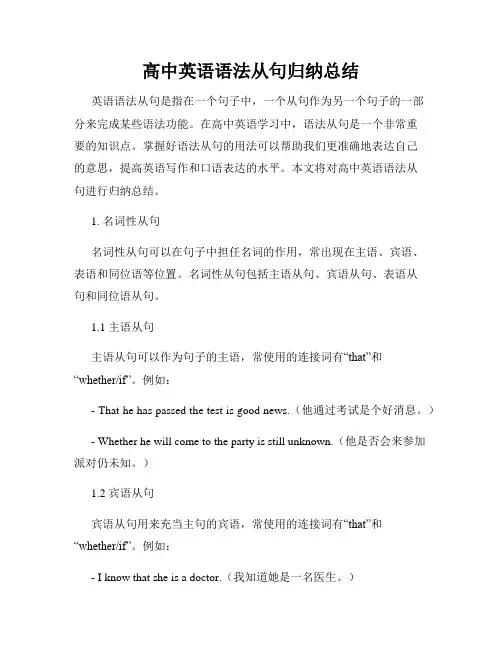
高中英语语法从句归纳总结英语语法从句是指在一个句子中,一个从句作为另一个句子的一部分来完成某些语法功能。
在高中英语学习中,语法从句是一个非常重要的知识点。
掌握好语法从句的用法可以帮助我们更准确地表达自己的意思,提高英语写作和口语表达的水平。
本文将对高中英语语法从句进行归纳总结。
1. 名词性从句名词性从句可以在句子中担任名词的作用,常出现在主语、宾语、表语和同位语等位置。
名词性从句包括主语从句、宾语从句、表语从句和同位语从句。
1.1 主语从句主语从句可以作为句子的主语,常使用的连接词有“that”和“whether/if”。
例如:- That he has passed the test is good news.(他通过考试是个好消息。
)- Whether he will come to the party is still unknown.(他是否会来参加派对仍未知。
)1.2 宾语从句宾语从句用来充当主句的宾语,常使用的连接词有“that”和“whether/if”。
例如:- I know that she is a doctor.(我知道她是一名医生。
)- He asked me whether/if I had finished my homework.(他问我是否已经完成了作业。
)1.3 表语从句表语从句用来简述主语的特征、性质或状态,常使用的连接词有“that”和“whether/if”。
例如:- The truth is that he is a liar.(事实是,他是个说谎者。
)- The question is whether/if we can solve the problem.(问题是我们是否能解决这个问题。
)1.4 同位语从句同位语从句用来解释或说明名词的具体内容,常使用的连接词有“that”和“whether/if”。
例如:- The fact that she passed the exam surprised everyone.(她通过了考试这个事实使每个人都惊讶。
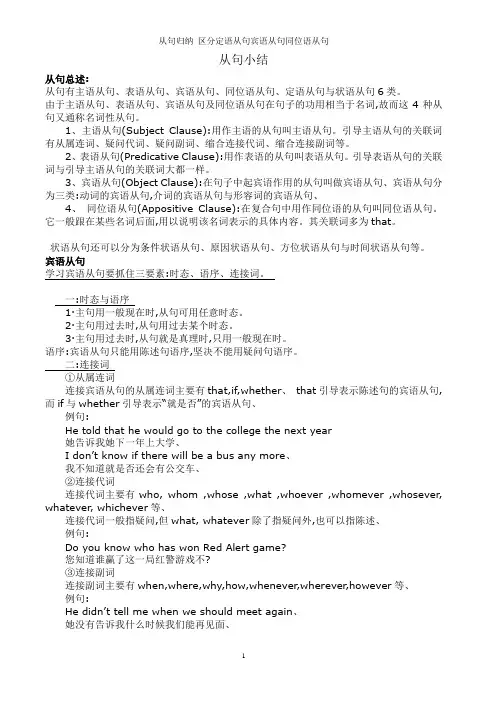
从句小结从句总述:从句有主语从句、表语从句、宾语从句、同位语从句、定语从句与状语从句6类。
由于主语从句、表语从句、宾语从句及同位语从句在句子的功用相当于名词,故而这4种从句又通称名词性从句。
1、主语从句(Subject Clause):用作主语的从句叫主语从句。
引导主语从句的关联词有从属连词、疑问代词、疑问副词、缩合连接代词、缩合连接副词等。
2、表语从句(Predicative Clause):用作表语的从句叫表语从句。
引导表语从句的关联词与引导主语从句的关联词大都一样。
3、宾语从句(Object Clause):在句子中起宾语作用的从句叫做宾语从句、宾语从句分为三类:动词的宾语从句,介词的宾语从句与形容词的宾语从句、4、同位语从句(Appositive Clause):在复合句中用作同位语的从句叫同位语从句。
它一般跟在某些名词后面,用以说明该名词表示的具体内容。
其关联词多为that。
状语从句还可以分为条件状语从句、原因状语从句、方位状语从句与时间状语从句等。
宾语从句学习宾语从句要抓住三要素:时态、语序、连接词。
一:时态与语序1·主句用一般现在时,从句可用任意时态。
2·主句用过去时,从句用过去某个时态。
3·主句用过去时,从句就是真理时,只用一般现在时。
语序:宾语从句只能用陈述句语序,坚决不能用疑问句语序。
二:连接词①从属连词连接宾语从句的从属连词主要有that,if,whether、that引导表示陈述句的宾语从句,而if与whether引导表示“就是否”的宾语从句、例句:He told that he would go to the college the next year她告诉我她下一年上大学、I don’t know if there will be a bus any more、我不知道就是否还会有公交车、②连接代词连接代词主要有who, whom ,whose ,what ,whoever ,whomever ,whosever, whatever, whichever等、连接代词一般指疑问,但what, whatever除了指疑问外,也可以指陈述、例句:Do you know who has won Red Alert game?您知道谁赢了这一局红警游戏不?③连接副词连接副词主要有when,where,why,how,whenever,wherever,however等、例句:He didn’t tell me when we should meet again、她没有告诉我什么时候我们能再见面、三:动词的宾语从句We all expect that they will win , for members of their team are stronger、我们都预料她们会赢,因为她们的队员更强壮、I have found out that all the tickets for the concert have been sold out、我发现这场音乐会的所有票都卖光了、make sure确保make up one’s mind下决心keep in mind牢记例句:Make sure that there are no mistakes in your papers before you turn them in、在上交试卷前确保没有任何错误、四:可运用形式宾语it代替的宾语从句①动词find,feel,consider,make,believe等后面有宾语补足语的时候,则需要用it做形式宾语而将that宾语从句后置、例句:I think it necessary that we take plenty of hot water every day 、我认为每天多喝开水就是有必要的、I feel it a pity that I haven’t been to the get-together、我没去聚会,感觉非常遗憾、②有些动词带宾语从句时寻要在宾语与从句前加it这类动词主要有:hate, take , owe, have, see to、例句:I hate it when they with their mouths full of food、我讨厌她们满嘴食物时说话、五:介词的宾语从句用wh-类的介词宾语从句例句:We are talking about whether we admit students into our club、我们正在讨论就是否让学生加入我们的俱乐部、I know nothing about my new neighbor except that he used to work with a company、对于我的新邻居我只知道她曾在一家公司上班,其她一无所知、六:形容词的宾语从句一般来说形容词不能带宾语,更不能带宾语从句。
三种易混从句的辨别三种易混从句的辨别英语中有三类从句,分别是名词性从句、定语从句和状语从句。
这三类从句的研究、掌握和使用对同学们来说是一个颇为复杂的过程。
本专题通过对比分析这三大从句的区别,归纳三大从句与动词不定式的转换规律,希望能帮助同学们掌握区分从句与解答从句类考题的方法,并学会在书面表达中正确使用从句。
定语从句、同位语从句和状语从句有时候在形式上很相似,下面提供一些区分的方法。
一、定语从句与同位语从句定语从句与前面的名词是修饰与被修饰的关系,而同位语从句是用来说明前面名词的内容的。
在定语从句中,that可指物或人,充当句子成分,如作宾语,可以被省略;而同位语从句中的that在从句中不充当任何句子成分,只起连接作用。
比较如下:①The news(that/which)he told us was exciting。
(定语从句,that/which在从句中作宾语,可以被省略)②The news that our team has won is exciting。
(同位语从句,that从句是说明news的内容的,that在从句中不作任何成分,但不能省略)特别提醒:一般情况下,同位语从句紧跟在它所说明的名词之后,可是有时为了表达的需要,名词与从句之间被另外一些内容分隔开了,叫“分隔同位语从句”。
对于这类同位语从句,一定要根据句意,找准其所说明的名词。
例如,2014年高考安徽卷的一道题目:The exact year_____ Angela and her family XXX in China was 2008.本题中的定语从句的先行词是the exact year,后面的定语从句Angela and her family XXX中动词spent后面缺少宾语,所以使用关系代词which引导这个定语从句,并在句中作宾语。
where的先行词通常是指地点的名词,关系副词when的先行词通常是表示时间的名词,why的先行词是the reason。
缶词性从句从句的分类主语从句宾语从句表语从句同位语从句PART1:英语从句三大类型按一般说法,可分为三大类14种从句。
一,名词性从句1主语从句Whetherit'srightornotremainstobeseen.2宾语从句Iwonderwhetherit'srightornot.3同位语从句Thisisaquestionwhetherit'srightornot.4表语从句Thequestioniswhetherit'srightornot.二,定语从句1限定性定语从句SheisthestudentwhocanspeakEnglishwell.2非限定性定语从句Sheisthestudent,whocanspeakEnglishwell.三,状语从句1时间状语从句Thefactwillcomeoutwhenhecomeshere.2地点状语从句Youcangowhereveryoulike.3原因状语从句Paymoreattentiontoyourlessonsbecauseyouareastudent.4方式状语从句Hewalksasifhewereaking.5目的状语从句ShewenttoJapansothatshecouldlearnJapanesewell.6结果状语从句ShewenttoJapansothatshelearnedJapanesewell.7条件状语从句Iwillunderstanditifhetellsme.8让步状语从句Heknowsalotthoughheislittle. PART2:经典名词性从句主语从句(subjectclauses)在复合句中起主语作用的从句叫主语从句。
引导主语从句的词有从属连词、、关系代词、连接副词等。
引导主语从句的关联词有从属连词that 、whether ,关系代词:who,what,which,whom,whose,whatever,whoever,whomever,whichever ;关系副词:when,where,how,why,however,whenever,wherever 等。
宾语从句欧阳家百(2021.03.07)一、宾语从句概说宾语从句是在复合句中起宾语作用的从句。
在谓语动词,介词和某些形容词等后面都可以接宾语从句。
同学们要掌握好宾语从句,主要应该注意以下三个关键:1.连接词:根据从句类型而定。
2.语序:用陈述句语序。
3.时态:根据主句中谓语动词的时态而定。
(自然、科学规律及真理可以除外)二、宾语从句的连接词:1. thatthat引导陈述意义的宾语从句,无实际意思,在从句中也不充当任何成分。
在口语和非正式文体中that常被省略。
She said that she missed us very much.她说她非常想念我们。
I think she is right.我认为她是对的(that被省略)2. whether, if:whether与if引导选择意义的宾语从句,意思为"是否"。
I wonder whether/ if she still lives here after so many years.这不知道经过这么之年她是否还住在这里。
Have you found out whether/if he is in London?你弄清楚他是否在伦敦了吗?3. what, who, whom, which这是一组连接代词,引导疑问意义的宾语从句。
Can you tell me what bread is made from?你能告诉我面包是由什么制造的吗?I can't remember who has come to my office.我不记得谁来过我的办公室了。
Tom asked me whom/who they were talking about.汤姆问我他们在谈论谁。
I want to know which is better.我想知道哪一个更好些。
whom引导宾语从句时一般可由who替换,但如果宾语从句的介词提前,则只能用whom,不能用who。
【中考英语专项复习——宾语从句】欧阳家百(2021.03.07)(一)宾语从句的种类宾语从句在句中作及物动词的宾语,或介词的宾语,或形容词的宾语。
根据引导宾语从句的不同连词,宾语从句可分为三类。
1. 由that引导的宾语从句。
that只有语法作用,没有实在的意义,在口语和非正式文体中可以省略。
例如:He said (that) he wanted to stay at home.She doesn’t know (that) she is seriously ill.I am sure (that) he will succeed.2. 由连接代词who, whom, whose, what, which和连接副词when, where, why, how引导的宾语从句。
这些连接代词和连接副词在宾语从句中充当某个成分。
例如:Do you know who (whom) they are waiting for?He asked whose handwriting was the best.Can you tell me where the No.3 bus stop is?I don’t know why the train is late.3. 由if或whether引导的宾语从句。
if和whether在句中的意思是“是否”。
例如:I want to know if (whether) he lives there.He asked me whether (if) I could help him.(二)宾语从句的语序宾语从句的语序应为陈述句的语序。
例如:I hear (that) physics isn’t easy. I think (that) you will like this school soon.Can you tell me how I can get to zoo?Please tell me when we’ll have the meeting.(三)宾语从句的时态1. 如果主句的时态是一般现在时,宾语从句该用什麽时态就用什麽时态。
怎么区分定从宾从同位语从句第一篇:怎么区分定从宾从同位语从句怎么区分定从宾从同位语从句?(从成分方面)老师说什么。
做在句子中做成分就是。
去掉以后句子不完整就是。
满意答案:从句按其在主句中的句法功能可分为三类,即名词性从句、形容词性从句(即定语从句)和副词性从句(即状语从句)。
引导从句的词称作关联句。
名词性从句包括主语从句、表语从句、宾语从句和同位语从句。
引导这些名词性从句的关联词包括: 从属连词that, if, whether;连接代词who, whoever, whom, whomever, which, whichever, what, whatever, whose;连接副词where, when, why, how。
其中, 从属连词只起连接作用, 在从句中不充当任何句法成分,而连接代词和连接副词既起连接作用, 在从句中又充当一定的成分.That Owen should have married his cousin is not at all surprising.The fact is that he didn't go to the dinner party.I don't know if he will attend the meeting.Have you heard the news that Mary is going to marry Tom? 你听说玛丽要和汤姆结婚的消息了吗?(that引导同位语从句)[提示] 1.在含有主语从句的复合句中, 为保持句子平衡, 常用it作形式主语,而将真正的主语从句置于句末.It's well known that water is indispensable to life.2.为保持句子平衡, that引导的宾语从句也常用it代替, 而将真正的宾语从句置于主句句末。
这常常出现在主句有形容词或分词作宾语补足语的情况下。
从句小结欧阳家百(2021.03.07)从句总述:从句有主语从句、表语从句、宾语从句、同位语从句、定语从句和状语从句6类。
由于主语从句、表语从句、宾语从句及同位语从句在句子的功用相当于名词,故而这4种从句又通称名词性从句。
1.主语从句(Subject Clause):用作主语的从句叫主语从句。
引导主语从句的关联词有从属连词、疑问代词、疑问副词、缩合连接代词、缩合连接副词等。
2.表语从句(Predicative Clause):用作表语的从句叫表语从句。
引导表语从句的关联词与引导主语从句的关联词大都一样。
3.宾语从句(Object Clause):在句子中起宾语作用的从句叫做宾语从句.宾语从句分为三类:动词的宾语从句,介词的宾语从句和形容词的宾语从句.4. 同位语从句(Appositive Clause):在复合句中用作同位语的从句叫同位语从句。
它一般跟在某些名词后面,用以说明该名词表示的具体内容。
其关联词多为that。
状语从句还可以分为条件状语从句、原因状语从句、方位状语从句和时间状语从句等。
宾语从句学习宾语从句要抓住三要素:时态、语序、连接词。
一:时态和语序1·主句用一般现在时,从句可用任意时态。
2·主句用过去时,从句用过去某个时态。
3·主句用过去时,从句是真理时,只用一般现在时。
语序:宾语从句只能用陈述句语序,坚决不能用疑问句语序。
二:连接词①从属连词连接宾语从句的从属连词主要有that,if,whether. that引导表示陈述句的宾语从句,而if和whether引导表示“是否”的宾语从句.例句:He told that he would go to the college the next year 他告诉我他下一年上大学.I don’t know if there will be a bus any more.我不知道是否还会有公交车.②连接代词连接代词主要有who, whom ,whose ,what ,whoever ,whomever ,whosever, whatever, whichever等.连接代词一般指疑问,但what, whatever除了指疑问外,也可以指陈述.例句:Do you know who has won Red Alert game?你知道谁赢了这一局红警游戏吗?③连接副词连接副词主要有when,where,why,how,whenever,wherever,however等.例句:He didn’t tell me when we should meet again.他没有告诉我什么时候我们能再见面.三:动词的宾语从句We all expect that they will win , for members of their team are stronger.我们都预料他们会赢,因为他们的队员更强壮.I have found out that all the tickets for the concert have been sold out.我发现这场音乐会的所有票都卖光了.make sure确保make up one’s mind下决心keep in mind牢记例句:Make sure that there are no mistakes in your papers before you turn them in.在上交试卷前确保没有任何错误.四:可运用形式宾语it代替的宾语从句①动词find,feel,consider,make,believe等后面有宾语补足语的时候,则需要用it做形式宾语而将that宾语从句后置.例句:I think it necessary that we take plenty of hot water every day .我认为每天多喝开水是有必要的.I feel it a pity that I haven’t been to the get-together.我没去聚会,感觉非常遗憾.②有些动词带宾语从句时寻要在宾语与从句前加it这类动词主要有:hate, take , owe, have, see to.例句:I hate it when they with their mouths full of food.我讨厌他们满嘴食物时说话.五:介词的宾语从句用wh-类的介词宾语从句例句:We are talking about whether we admit students into our club.我们正在讨论是否让学生加入我们的俱乐部.I know nothing about my new neighbor except that he used to work with a company.对于我的新邻居我只知道他曾在一家公司上班,其他一无所知.六:形容词的宾语从句一般来说形容词不能带宾语,更不能带宾语从句。
但以下形容词除外:sure,certain,glad,please,happy,sorry,afraid,satisfied,surprisedI am sure I will pass the exam.我确信我会通过考试.I am sorry that I have troubled you so long.很抱歉我这么长时间在打扰你.七:if,whether在宾语从句中的区别①if和whether在作“是否”解时,引导宾语从句常放在动词know,ask,care,wonder,find out等之后,介词后一般不用if②少数动词,如:leave,put,discuss,doubt后的宾语从句常用whether.③whether后可以加or not,但是if不可以.④在不定式前只能用whether.如:I can’t decide whether to stay. 我不能决定是否留下。
⑤避免歧异时,我们常用whether而不用if.八:哪些宾语从句不可以省略引导词that①当一个动词带有两个或两个以上宾语从句时,此时第一个that可以省略,第二个that不可以省略;②当宾语从句有it做其先行词时;九:宾语从句的否定转移主句的谓语动词是think,believe,imagine,suppose,consider,espect,fancy,guess等,并且主句的主语是第一人称而且为一般现在时,从句的否定词一般要转移到主句上来,其反义疑问句一般与宾语从句一致.I don’t think he will come to my party.而不能说成I think he won’t come to my party.我认为他不会来我的舞会.I don’t believe that man is killed by Jim,is he?我认为那个人不是Jim所杀的,是不是?★如果宾语从句中有某个含有否定意义的形容词或副词,其反义疑问句要用肯定形式.例句:We find that he never listens to the teacher carefully,does he?我们发现他从来不仔细听老师讲课,是不是?十:宾语从句的时态和语序当主句为现在时或将来时的时候,宾语从句的时态一般不受主句的时态所影响.当主句为过去时的时候,从句只能用和过去相关的时态。
例句:The reporter asked if the government would take necessary measures to put down the to-do.记者问政府是否会采取必要的措施镇压骚乱.★如果从句是一个客观真理,那么从句的时候不根据主句的时态而变化例句:The teacher said that the moon goes around the earth yesterday.老师昨天说月亮绕着地球转.★宾语从句的插入语形式例句:Who do you think the public might choose as their favorite singer this year?你认为今年公众会选谁为他们最喜欢的歌手.同位语从句(Appositive Clause):在复合句中用作同位语的从句叫同位语从句。
它一般跟在某些名词后面,用以说明该名词表示的具体内容。
其关联词多为that。
一、如:I heard the news that our team had won.我听到了我们队获胜的消息。
I had no idea that you were here.我不知道你在这里。
二、可以跟同位语从句的名词通常有news,idea,fact,promise,question,doubt,thought,hope,message,suggestion,words(消息),possibility等,可展开来的抽象名词。
如:I’ve come from Mr wang with a message that he won’t be able to see you this afternoon.我从王先生那里来,他让我告诉你他今天下午不能来看你了。
三、英语中引导同位语从句的词通有连词that,whether,连接副词 how,when,where等。
根据句意决定该用哪一个。
l have no idea When he will be back.我不知道他什么时候回来。
定语从句(Attributive Clause):用作定语的从句叫定语从句。
定语从句一般皆放在被它所修饰的名(代)词之后,这种名(代)词就叫作先行词(Antecedent)。
引导定语从句的关联词为关系代词和关系副词。
关系代词在定语从句中可用作主语、宾语、定语等;关系副词在定语从句中用作状语。
①引导定语从句的关联词有who, whom, whose, that, when, where, why 和which. 在非限制定语从句中, 只可用which, who, whose, where , when., 如果指代前面整个句子, 多用which.例句:The dog that/which was lost has been found.(失踪的狗已经找到了。
)Those who are in favor of the proposal are expected to discuss it in detail after the meeting.(有人认为那些对这个提案有兴趣的人最好是在会后再具体讨论它。
)There are many organizations whose purpose is to help the homeless.(存在着许多旨在帮助无家可归者的组织。